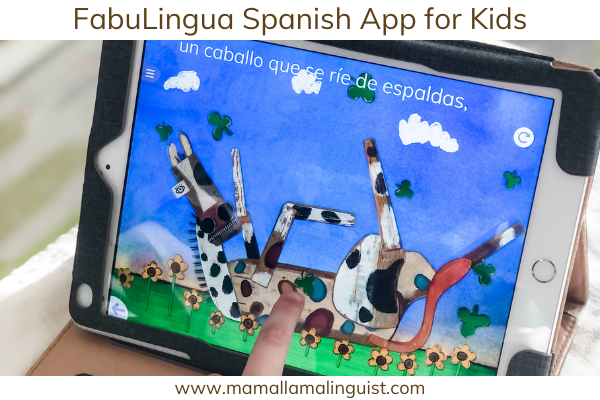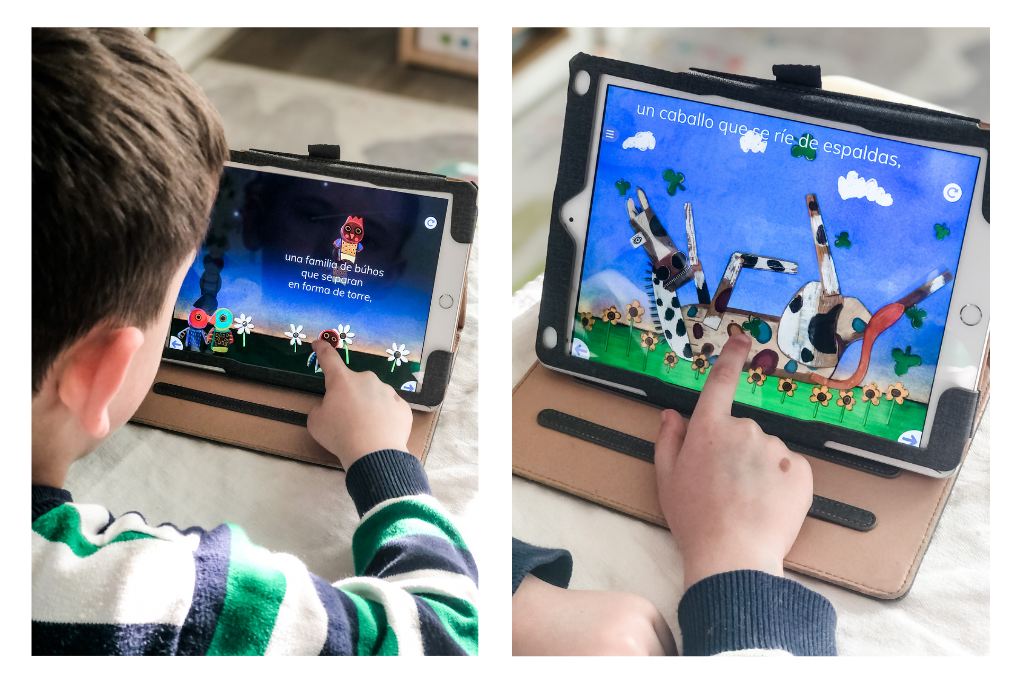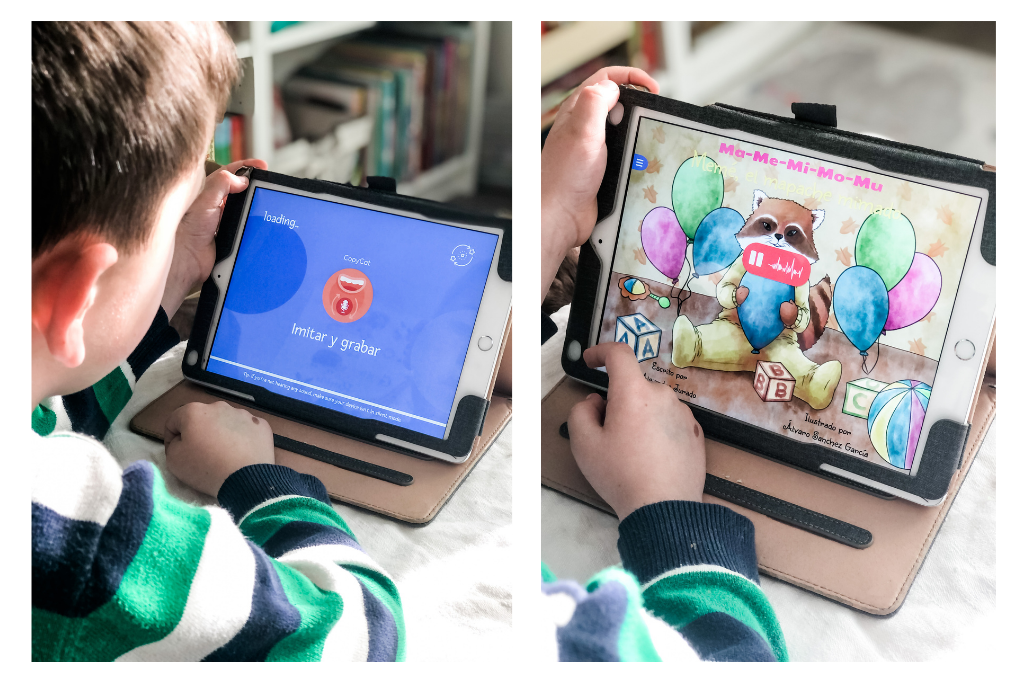In this post: An honest review of FabuLingua; a story-based Spanish learning app for kids.
I have always encouraged a love of literacy in our bilingual home. I have prioritized growing our home library and modeled a love for reading. I truly believe in the power of stories and the magic of children’s literature.
Although we take advantage of many tools and resources, reading aloud has always been my favorite way to teach my kids Spanish. It is perhaps the simplest, yet most powerful resource in our bilingual family toolkit.
However, in our ever growing digital world, my children also love playing on their devices. Setting screen time limitations is a battle for most modern day families~ I know it was for ours!
Eventually, I discovered a parenting hack that changed everything! I started to learn how to leverage their screen time for language learning, with educational apps and carefully selected TV shows.
That’s why I was thrilled to discover FabuLingua, a Spanish learning app that teaches children Spanish through interactive stories and fun educational games.

This post may contain affiliate links. As an Amazon associate I earn from qualifying purchases.
I remember the day I met Leslie Omana Begert, mom and co-founder of FabuLingua. She was visiting San Diego for a conference and I had the absolute privilege of dining with her in Solana Beach one evening.
Leslie and I share a passion for languages and raising bilingual children, as well as tapas! We talked for hours and Leslie showed me first hand inside the FabuLingua app.
She explained the theory and pedagogy behind its design and I was blown away with how much thought and research was behind it.
Table of Contents
What is FabuLingua?
Fabulingua is a subscription-based Spanish app that teaches children Spanish through interactive stories and games.
In a rapidly-growing digital market, children are experiencing more screen time than ever before. Often as a parent, I battle daily with enforcing limitations and finding screen-free activities to disconnect my kids.
FabuLingua founders Leslie and Mark Begert, who are also parents, recognized these common struggles and identified a niche in the education industry.
After years of research, and personal experience and success raising bilingual children, they essentially ‘cracked the code’ and responded by creating an interactive digital mobile game that teaches your child Spanish through comprehensible input.
What is Comprehensible Input?
Before we dig into the app, I wanted to explain a little more about the language science behind it, because as a parent, it really helped me understand the depth of my children’s learning while using the app and its overall effectiveness.
The app’s pedagogy is rooted in the extensive research of Dr Kraschen and his theory of comprehensible input for effective language acquisition.
By definition:
“Comprehensible input is language input that can be understood by listeners despite them not understanding all the words and structures in it.” (British Council).
It is language in context that is meaningful.
Although aware of this theory for successful language acquisition, I had not fully understood its effectiveness until we began using the FabuLingua app.
FabuLingua harnesses the child’s natural curiosity for playing games and exposes them to Spanish vocabulary and full sentences through comprehensible stories.

Invisible Learning
Stories are powerful and arguably the most effective way to teach your kids Spanish. So the fact that this whole app is designed around a methodology that uses animated stories to teach a language immediately grabbed my attention.
The pedagogy of FabuLingua is rooted in language learning science, and designed around the concept of ‘invisible learning’.
This is where the parenting hack comes in! Your children are having fun, playing on their devices, but learning Spanish subconsciously.
Unlike many other Spanish apps, FabuLingua is not set up to ‘test’ your child, but rather to engage them in interactive stories with activities that reinforce their understanding and pronunciation. It gently increases the level of difficulty as the child progresses along the storypath.
Magical Translations® is another key feature of the story-telling method that essentially translates each sentence after the Spanish is heard. It is done very effectively as it allows the child to follow along and develop their comprehension.
You can choose to hear the story read aloud in Spanish followed by an English translation for each sentence, or toggle to Spanish only for a more immersive experience. Personally, I found that my children engaged much more with the magical translations feature.
What Games are Included?
In addition to a whole collection of beautifully animated stories, there are also several games in the FabuLingua app and I wanted to share our favorites!
When you open the app, you can create a profile and then you choose different ‘characters’, usually animals, which each come with their own story and games.
As the child masters each activity, they continue on their storypath, unlocking more interactive games and challenges. Your child will also earn coins, stickers (calcomanías) and keys as rewards~ this was a feature that my 5 year old son really loved.

CopyCat
The CopyCat feature proved the most hilarious and engaging for my kids, and quite possibly the highlight of the app for them.
The child is able to listen to the narration of a story, then after each sentence, your child can record their own voice and play it back. They then compare it to the native speaker audio and THEY decide whether it sounds right. There is no big red ‘X’ or loud, alarming noise telling them when their pronunciation is ‘wrong’.
This is not only a great way to increase their focus on pronunciation and phonological awareness, but it builds their confidence in speaking the target language. This is often the most challenging aspect for language learners.
Vocabulary Games
There are also many games that your child can enjoy after they have mastered and understood the story.
For example, there are matching games, letter scrambles (letras revueltas) and even syllable scrambles (sílabas revueltas). I have never seen this in any other Spanish app.
Breaking down the syllables for words found in the story is an excellent method for reinforcing the vocabulary and practicing spelling.
Magic Sticker Book
A feature that my 3 year old really enjoyed was the Sticker Book. This is where all their sticker rewards are stored that your child earns over the course of the storypath.
Your child can drag stickers onto a blank page, adjust the size and make an artistic design, even with 3D dimensions. It is simple but really fun as the child can hear the vocabulary repeated again and play with their reward stickers.
Who is FabuLingua for?
FabuLingua is an excellent tool for both Spanish beginners and families already raising bilingual and biliterate children.
After using the app for several weeks, I would recommend it for children who are emergent or early readers~ ages 5+.
The app is unique in its approach of storytelling and requires that the child follows along with the words on a screen as the story is read aloud. I found that my 3 year old could not concentrate on this and often lost interest after a few pages, whereas my 5 year old really enjoyed every aspect of the app.
To play the app independently, without the support of a parent, your child does need a solid foundation in letter recognition. Many of the games also require that your child can read syllables, or at least know how to sound out and spell words.
Many schools are also using the software for their students to complement their Spanish curriculum. I wish I had had access to this amazing language learning tool when I was teaching in schools!
Concluding Thoughts on FabuLingua
I wholeheartedly recommend the FabuLingua app for families looking for ways to leverage their child’s screen time for educational purposes.
My son’s vocabulary has exploded by hearing the beautifully narrated stories in the app. But beyond that, this platform has supported him in learning to read in Spanish. He now has a much deeper understanding of the sounds and pronunciation differences in the Spanish language.
Overall, FabuLingua is an engaging and affordable resource for families like mine, who are committed to raising bilingual and biliterate children in English and Spanish.
Try FabuLingua FREE for 30 Days
FabuLingua’s digital platform is extremely affordable and a very helpful resource for families raising bilingual and biliterate children.
It is available on iOS and Android devices.
Click this link from your mobile device and get your first 30 days FREE when you subscribe!
(make sure you click on the above link from your mobile device – not from your laptop!)
When you subscribe, your best value is an annual subscription for $31.99! Monthly options are available too. Cancel anytime.
This post is sponsored, but all opinions are my own. I only share about products that I use with my own children and love.
Related Posts:

i am so happy i read your post today. i’m also a linguist and former spanish teacher. recently a former student asked me to tutor her children as they begin to learn the language and culture. i’ll be looking thru the activities and suggested app. really looking forward to it!!!!
How wonderful Mirta! It brings me so much joy to read this. I hope you love the app as much as we do and the tutoring- so awesome!